Blog & Latest Updates
Fly Fishing Articles
Insects by Common Name


Animal Phylum Arthropoda (Arthropods)
Taxonomic Navigation -?-
Kingdom
Animalia (Animals)
» Phylum Arthropoda (Arthropods)
| Class in Arthropoda | ||
| ArachnidaMites and Spiders | 0 | 1 |
| CollembolaSpringtails | 0 | 0 |
| Crustacea-MalacostracaCrayfish, Scuds, and Sowbugs | 0 | 10 |
| Crustacea-Maxillopoda | 0 | 0 |
| InsectaInsects | 0 | 114 |
Common Name
| Match | Common Name |
| Arthropods |
This is page 44 of specimens of Arthropoda. Visit the main Arthropoda page for:
- The behavior and habitat of Arthropoda.
- 122 underwater pictures of Arthropoda.
Pictures of 1244 Arthropod Specimens:
Polycentropus (Brown Checkered Summer Sedges) Caddisfly Larva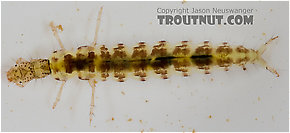 View 4 Pictures
View 4 Pictures
 View 4 Pictures
View 4 PicturesCollected May 13, 2007 from the Delaware River in New York
Added to Troutnut.com by Troutnut on May 18, 2007
Added to Troutnut.com by Troutnut on May 18, 2007
Onocosmoecus unicolor (Great Late-Summer Sedge) Caddisfly Larva View 3 Pictures
View 3 Pictures
 View 3 Pictures
View 3 PicturesCollected March 1, 2004 from unknown in Wisconsin
Added to Troutnut.com by Troutnut on January 25, 2006
Added to Troutnut.com by Troutnut on January 25, 2006
Ephemerella aurivillii Mayfly Nymph View 3 PicturesExamination of this specimen under a microscope revealed that it does have small abdominal tubercles (
View 3 PicturesExamination of this specimen under a microscope revealed that it does have small abdominal tubercles (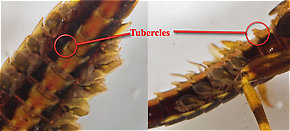 Tubercle: Various peculiar little bumps or projections on an insect. Their character is important for the identification of many kinds of insects, such as the nymphs of Ephemerellidae mayflies.), 2-banded femora (
Tubercle: Various peculiar little bumps or projections on an insect. Their character is important for the identification of many kinds of insects, such as the nymphs of Ephemerellidae mayflies.), 2-banded femora (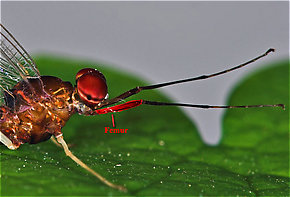 Femur: The main segment of an insect's leg close to the body, in between the tibia and the trochanter.), and banded tails.
Femur: The main segment of an insect's leg close to the body, in between the tibia and the trochanter.), and banded tails.
 View 3 PicturesExamination of this specimen under a microscope revealed that it does have small abdominal tubercles (
View 3 PicturesExamination of this specimen under a microscope revealed that it does have small abdominal tubercles (
A few (not all) of the abdominal tubercles on this Ephemerella needhami nymph are circled. They are especially large in this species.

The femur of this Isonychia bicolor mayfly spinner is highlighted in red.
Collected February 5, 2004 from unknown in Wisconsin
Added to Troutnut.com by Troutnut on January 25, 2006
Added to Troutnut.com by Troutnut on January 25, 2006
Ephemerella aurivillii Mayfly Nymph View 3 Pictures
View 3 Pictures
 View 3 Pictures
View 3 PicturesCollected February 5, 2004 from unknown in Wisconsin
Added to Troutnut.com by Troutnut on January 25, 2006
Added to Troutnut.com by Troutnut on January 25, 2006
Siphlonurus quebecensis (Gray Drake) Mayfly Nymph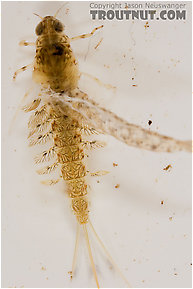 View 5 PicturesI photographed this nymph in the middle of molting between one instar (Instar: Many invertebrates molt through dozens of progressively larger and better-developed stages as they grow. Each of these stages is known as an instar. Hard-bodied nymphs typically molt through more instars than soft-bodied larvae.) and the next (not hatching).
View 5 PicturesI photographed this nymph in the middle of molting between one instar (Instar: Many invertebrates molt through dozens of progressively larger and better-developed stages as they grow. Each of these stages is known as an instar. Hard-bodied nymphs typically molt through more instars than soft-bodied larvae.) and the next (not hatching).
 View 5 PicturesI photographed this nymph in the middle of molting between one instar (Instar: Many invertebrates molt through dozens of progressively larger and better-developed stages as they grow. Each of these stages is known as an instar. Hard-bodied nymphs typically molt through more instars than soft-bodied larvae.) and the next (not hatching).
View 5 PicturesI photographed this nymph in the middle of molting between one instar (Instar: Many invertebrates molt through dozens of progressively larger and better-developed stages as they grow. Each of these stages is known as an instar. Hard-bodied nymphs typically molt through more instars than soft-bodied larvae.) and the next (not hatching).Collected May 13, 2007 from the Delaware River in New York
Added to Troutnut.com by Troutnut on May 18, 2007
Added to Troutnut.com by Troutnut on May 18, 2007
Isonychia bicolor (Mahogany Dun) Mayfly Nymph View 4 Pictures
View 4 Pictures
 View 4 Pictures
View 4 PicturesCollected February 7, 2004 from the Namekagon River in Wisconsin
Added to Troutnut.com by Troutnut on January 25, 2006
Added to Troutnut.com by Troutnut on January 25, 2006
Ephemerella subvaria (Hendrickson) Mayfly Nymph View 3 PicturesHere's another nymph with the strange brownish coloring rather than the olive I usually see for subvaria. I suspect it's the same species and it's just wide individual variation.
View 3 PicturesHere's another nymph with the strange brownish coloring rather than the olive I usually see for subvaria. I suspect it's the same species and it's just wide individual variation.
 View 3 PicturesHere's another nymph with the strange brownish coloring rather than the olive I usually see for subvaria. I suspect it's the same species and it's just wide individual variation.
View 3 PicturesHere's another nymph with the strange brownish coloring rather than the olive I usually see for subvaria. I suspect it's the same species and it's just wide individual variation.Collected February 7, 2004 from unknown in Wisconsin
Added to Troutnut.com by Troutnut on January 25, 2006
Added to Troutnut.com by Troutnut on January 25, 2006
Capniidae (Snowflies) Stonefly Adult View 3 PicturesThis drowned Capniidae adult showed up in my drift net sample while I was looking for nymphs. I took photos of the drowned adult in water like a nymph.
View 3 PicturesThis drowned Capniidae adult showed up in my drift net sample while I was looking for nymphs. I took photos of the drowned adult in water like a nymph.
 View 3 PicturesThis drowned Capniidae adult showed up in my drift net sample while I was looking for nymphs. I took photos of the drowned adult in water like a nymph.
View 3 PicturesThis drowned Capniidae adult showed up in my drift net sample while I was looking for nymphs. I took photos of the drowned adult in water like a nymph.Collected March 29, 2005 from Salmon Creek in New York
Added to Troutnut.com by Troutnut on April 7, 2006
Added to Troutnut.com by Troutnut on April 7, 2006
Ephemerella invaria (Sulphur Dun) Mayfly Nymph View 4 PicturesI looked at this nymph closely under a microscope to ascertain some key features I was wondering about in previous photographs of similar specimens. It definitely does have the fan-tail characteristic of the Ephemerella genus. It also has strongly 2-banded tibiae (
View 4 PicturesI looked at this nymph closely under a microscope to ascertain some key features I was wondering about in previous photographs of similar specimens. It definitely does have the fan-tail characteristic of the Ephemerella genus. It also has strongly 2-banded tibiae (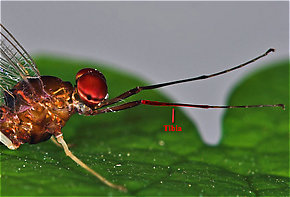 Tibia: A middle segments in the leg of an insect, located between the femur and the tarsus.) and definite tiny abdominal tubercles (
Tibia: A middle segments in the leg of an insect, located between the femur and the tarsus.) and definite tiny abdominal tubercles ( Tubercle: Various peculiar little bumps or projections on an insect. Their character is important for the identification of many kinds of insects, such as the nymphs of Ephemerellidae mayflies.).
Tubercle: Various peculiar little bumps or projections on an insect. Their character is important for the identification of many kinds of insects, such as the nymphs of Ephemerellidae mayflies.).
 View 4 PicturesI looked at this nymph closely under a microscope to ascertain some key features I was wondering about in previous photographs of similar specimens. It definitely does have the fan-tail characteristic of the Ephemerella genus. It also has strongly 2-banded tibiae (
View 4 PicturesI looked at this nymph closely under a microscope to ascertain some key features I was wondering about in previous photographs of similar specimens. It definitely does have the fan-tail characteristic of the Ephemerella genus. It also has strongly 2-banded tibiae (
The tibia of this Isonychia bicolor mayfly spinner is highlighted in red.

A few (not all) of the abdominal tubercles on this Ephemerella needhami nymph are circled. They are especially large in this species.
Collected February 7, 2004 from unknown in Wisconsin
Added to Troutnut.com by Troutnut on January 25, 2006
Added to Troutnut.com by Troutnut on January 25, 2006
Baetidae (Blue-Winged Olives) Mayfly Nymph View 3 PicturesThis specimen has indistinct gill veinlets (Veinlet: Short insect wing veins connecting the major longitudinal veins to the wing margin.), a rounded seventh gill, and no bands on the tails.
View 3 PicturesThis specimen has indistinct gill veinlets (Veinlet: Short insect wing veins connecting the major longitudinal veins to the wing margin.), a rounded seventh gill, and no bands on the tails.
 View 3 PicturesThis specimen has indistinct gill veinlets (Veinlet: Short insect wing veins connecting the major longitudinal veins to the wing margin.), a rounded seventh gill, and no bands on the tails.
View 3 PicturesThis specimen has indistinct gill veinlets (Veinlet: Short insect wing veins connecting the major longitudinal veins to the wing margin.), a rounded seventh gill, and no bands on the tails.Collected February 7, 2004 from unknown in Wisconsin
Added to Troutnut.com by Troutnut on January 25, 2006
Added to Troutnut.com by Troutnut on January 25, 2006
Top 10 Fly Hatches
Top Gift Shop Designs
Eat mayflies.
Top Insect Specimens
Miscellaneous Sites
Troutnut.com is copyright © 2004-2024 Jason
Neuswanger (email Jason). See my FAQ for information about use of my images.
 privacy policy
privacy policy
